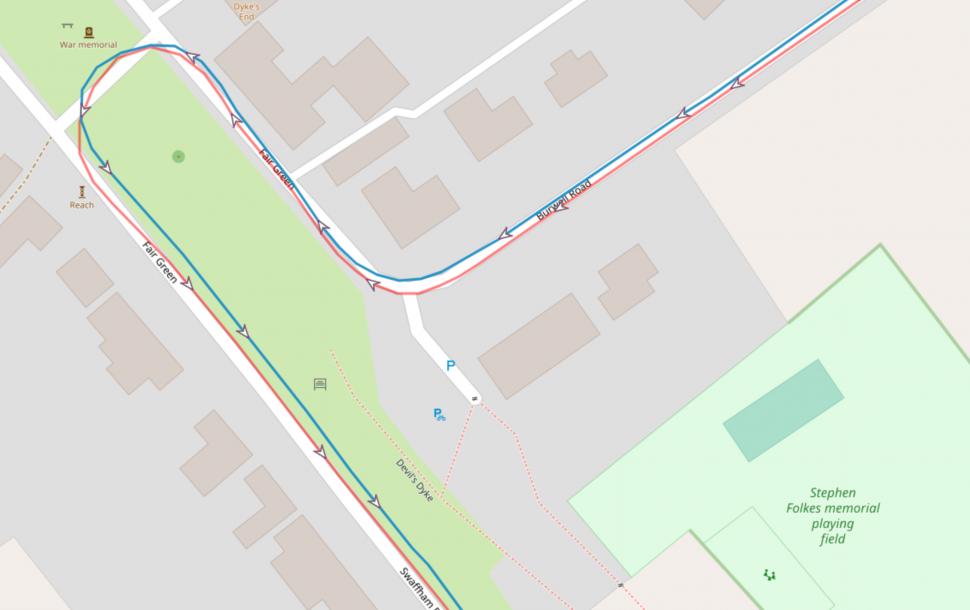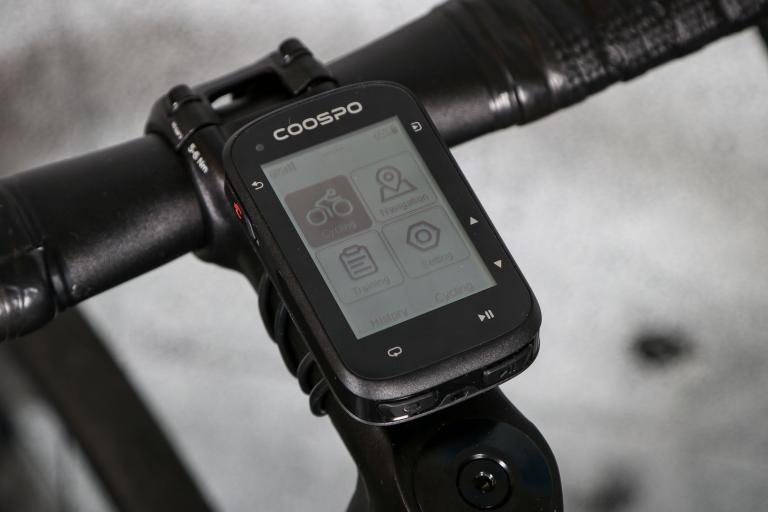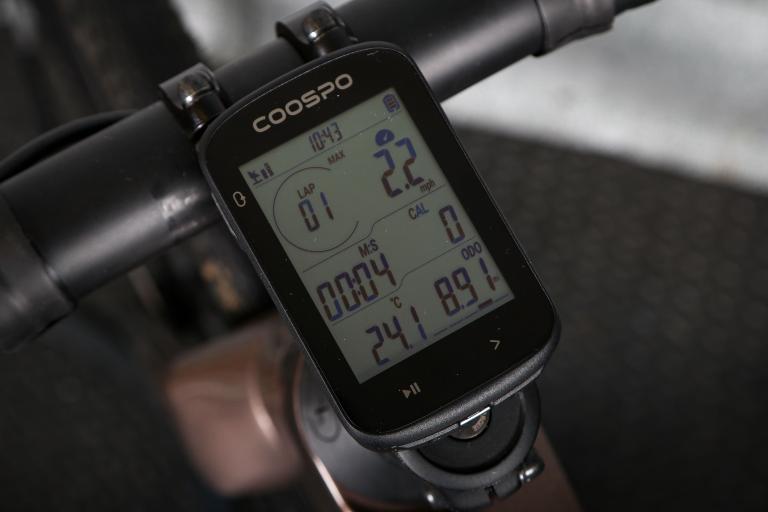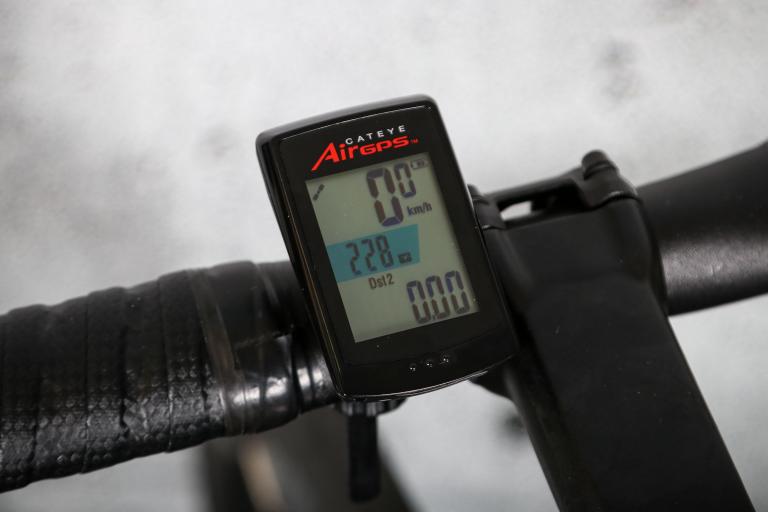- News
- Reviews
- Bikes
- Accessories
- Accessories - misc
- Computer mounts
- Bags
- Bar ends
- Bike bags & cases
- Bottle cages
- Bottles
- Cameras
- Car racks
- Child seats
- Computers
- Glasses
- GPS units
- Helmets
- Lights - front
- Lights - rear
- Lights - sets
- Locks
- Mirrors
- Mudguards
- Racks
- Pumps & CO2 inflators
- Puncture kits
- Reflectives
- Smart watches
- Stands and racks
- Trailers
- Clothing
- Components
- Bar tape & grips
- Bottom brackets
- Brake & gear cables
- Brake & STI levers
- Brake pads & spares
- Brakes
- Cassettes & freewheels
- Chains
- Chainsets & chainrings
- Derailleurs - front
- Derailleurs - rear
- Forks
- Gear levers & shifters
- Groupsets
- Handlebars & extensions
- Headsets
- Hubs
- Inner tubes
- Pedals
- Quick releases & skewers
- Saddles
- Seatposts
- Stems
- Wheels
- Tyres
- Health, fitness and nutrition
- Tools and workshop
- Miscellaneous
- Tubeless valves
- Buyers Guides
- Features
- Forum
- Recommends
- Podcast
review
 Coospo BC107 GPS Bike Computer
Coospo BC107 GPS Bike Computer£49.99
VERDICT:
Very good GPS bike computer at an extremely reasonable price
Easy to use
Inexpensive
Long battery life
Included out-front mount
Calorie algorithm ignores power
Time zone setting requires app
Weight:
66g
Contact:
At road.cc every product is thoroughly tested for as long as it takes to get a proper insight into how well it works. Our reviewers are experienced cyclists that we trust to be objective. While we strive to ensure that opinions expressed are backed up by facts, reviews are by their nature an informed opinion, not a definitive verdict. We don't intentionally try to break anything (except locks) but we do try to look for weak points in any design. The overall score is not just an average of the other scores: it reflects both a product's function and value – with value determined by how a product compares with items of similar spec, quality, and price.
What the road.cc scores meanGood scores are more common than bad, because fortunately good products are more common than bad.
- Exceptional
- Excellent
- Very Good
- Good
- Quite good
- Average
- Not so good
- Poor
- Bad
- Appalling
The Coospo BC107 is a very tidy and extremely well-priced GPS bike computer. It's cheap but by no means nasty, and by keeping things simple Coospo has made it very straightforward to use.
For a mere 50 quid you get a basic set of GPS bike computer functions including altitude, gradient, and calorie calculation, as well as the basics like speed and distance. Unlike some budget computers it's compatible with ANT+ sensors (though not Bluetooth accessories – Bluetooth is only used to communicate with your phone) and power meters so with a budget single-sided crank power sensor like a 4iiii Shimano 105 you can be training with power for less than £300.
> Buy now: Coospo BC107 for £39.49 from Amazon
Best of all it's straightforward to use and accurate. It found my various sensors easily and it's quick to find satellites, getting a fix well within the window I like to call 'pre-ride faffing about'.
When you hit the start button you get a three-second countdown before it starts recording, which is kinda cute. Once under way you can switch between three screens, showing current data, averages and maximums. There's a lot of information on display here and no way to simplify or customise it. More expensive GPS computers have displays you can tailor, but the key there is 'more expensive'; here you get the information you get, and that's it.
Coospo has done a decent job of prioritising the data by size. Speed is shown in nice big letters, time of day in tiny ones; other data is presented in sizes in between.
The BC107 gets its location data from the original US GPS satellite constellation and China's BeiDou system. More expensive computers also use additional global navigation satellite systems such as Russia's GLONASS and the European Union's Galileo as well, which is claimed to increase accuracy.
Here's a comparison of the BC107's GPS trace in red, with the data from my Garmin Edge 1030 Plus in blue.
As you can see they're close as makes no difference.
To get your ride data off the Coospo BC107 you use the CoospoRide app to transfer it to your phone and then via Bluetooth to a Mac or PC, or straight to Strava. However, while the BC107 speaks Bluetooth to your phone, it'll only receive data from ANT+ sensors; not a big deal as Bluetooth-only sensors are uncommon.
If you download to your desktop or laptop it's a .fit file (as produced by Garmin devices) which you can then upload to the ride-logging site of your choice or chuck it in Golden Cheetah. You can even upload it to Garmin Connect.
Looking at the .fit files the BC107 produces, it logs data once per second. There's no setting to change this to conserve memory, and you have to manage the BC107's 8MB of on-board memory yourself. The app shows you how much memory you've used. I found it used about 2B/minute, so there's capacity for about 60 hours of riding (Coospo claims 80).
File transfer worked seamlessly with my iPhone 7, iPhone 12 Pro and MacBook Air, though it's not automatic. With a Garmin device you stop recording and save your ride and the rest happens automatically. You have to manually hit 'sync' in CoospoRide, though you can set it up to automatically lob your ride to Strava once that's done.
The included mounts – one out-front, one directly mounted on the handlebar – are clones of Garmin quarter-turn mounts, so you've access to a huge range of aftermarket mounts. It's rather nice to get an out-front mount with a £50 GPS; it's not something you'll find in the box with some base model GPS units.
Annoyances are minor. Despite it having your location from GPS, the BC107 needs to be told via the app which time zone you're in, and doesn't therefore automatically adjust for British Summer Time.
The one major fault I could find is that even when used with a power meter the BC107's estimate of how many calories you've burned is way off; it's as bad as early Garmin units like the Edge 705, about which I wrote: 'Treat this feature as a way of comparing rides for effort. If you eat to replace the food you have just burned, you'll turn into a blimp.' Same applies here, then.
Value
My perception here is coloured by being flabbergasted that you can get a bike GPS unit for 50 quid at all, given the original 'cheap' GPS, the Garmin Edge 205, was £170 in 2007 (the equivalent of £250 in 2022 money), lacked a load of features available here, and was notoriously rubbish under tree cover or among tall buildings.
Setting that aside, this is, as far as I can tell, the cheapest bike GPS computer you can buy, and while Coospo has had to leave out a couple of 'nice to have' features, it does everything I want in a computer for recording a ride and displaying ride data as I ride.
> Buyer’s Guide: 10 of the best cheap GPS cycling computers
The cheapest GPS we've tested recently is the £65 Bryton Rider 15E Neo. The BC107 is quite similar, to be honest, but brings ANT+ and power meter compatibility to the party, which the Bryton lacks. The BC107 also boasts longer battery life and an amusing countdown to start your ride, though it lacks the Bryton's heading function.
Who should buy the Coospo BC107?
Anyone who wants essential ride data and ride logging at a very reasonable price. And unless you're absolutely strapped for cash this is a great alternative to an old-style bike computer as it doesn't need sensors, wheel size input or any of the other faff we had to do before GPS bike computers.
The Coospo BC107 is also handy as a second screen alongside a mapping computer. I used it to display speed and so on while using my Garmin Edge 1030 Plus for navigation. A bit self-indulgent? Maybe, but it's nice to have a back-up in case of a Garmin crash (the Edge 1030 Plus has been rock-solid for me; some previous Garmins not so much).
Highly recommended.
Verdict
Very good GPS bike computer at an extremely reasonable price
road.cc test report
Make and model: Coospo BC107 GPS Bike Computer
Size tested: NA
Tell us what the product is for and who it's aimed at. What do the manufacturers say about it? How does that compare to your own feelings about it?
Coospo says:
The BC107 was designed to be small but powerful.
BC107 may not as professional as [the more expensive] BC200, but it is equipped with all the basic functions of a GPS bike computer, which is perfectly suitable for beginners.
Compact and Lightweight Design
Although BC107 is an entry-level GPS bike computer, we spent 1000 hours adjusting its design. The streamlined design of BC107 shows the beauty of fluid.
GPS and BEIDOU Positioning
BC107 has GPS+BEIDOU double satellite positioning, which can provide accurate GPS data all over the world. After power is on, it will automatically capture GPS and Beidou signals and calibrate the time.
ANT+ Sensor Compatibility
Built for both budget and convenience, BC107 maximizes compatibility by working perfectly with ANT+ sensors, such as heart rate monitor, speed and cadence sensor, power meter.
Note: BC107 only supports ANT+ connection and does not support Bluetooth connection for the time being.
Sync To Strava
You can sync activity (.fit file) to Strava via Coosporide App on your phone.
Note: you can not export fit file from BC107 by USB.
CoospoRide APP Support
By CoospoRide app, you can set the BC107 easily, sync cycling data to the app to analyze, and get the latest update of firmware.
2.4 Inch Screen with Auto Backlight
2.4-inch sunlight-readable display, automatically sensing the environment to turn on the backlight. It is a screen that's ready for any adventure.
28 Hours Battery Life
BC107 provides 28 hours continuous battery life with GPS enabled, which is enough for a long ride.
IP67 Waterproof
Coming with IP67 rating, you can ride daily without fear of rain.
Quick Install and Uninstall
Compatible with various bike mounts and different locking systems. Just mount the device on the handlebar, turn it on and be good to go.
Tell us some more about the technical aspects of the product?
Physical dimensions: 80x54x20.64mm
Display size: 2.4in FSTN
Weight: 64g
Automatic Backlight: Yes
Battery life: 28 hours with GPS
Charging Time: 2 hours
Positioning System: GPS & BDS
Routing & Navigation: No
Storage: 8M(80 hours history)
In the box
* BC107 device main unit
* USB cable
* Bike mount
* User manual
* Rubber ring
* Rubber mat
* Mini allen wrench
Our sample included an out-front mount too.
Rate the product for quality of construction:
8/10
Tidily put together.
Rate the product for performance:
8/10
While the BC107 has quirks, it nails the basic functions of a GPS computer; you really can't complain for just 50 quid.
Rate the product for weight (if applicable)
9/10
At just 66g (plus whichever mount you choose) it's not going to weigh you down.
Rate the product for value:
10/10
My perception here is coloured by being flabbergasted that you can get a bike GPS unit for 50 quid at all, given the original 'cheap' GPS, the Garmin Edge 205, was £170 in 2007 (the equivalent of £250 in 2022 money), lacked a load of features available here, and was notoriously rubbish under tree cover or among tall buildings.
Setting that aside, this is, as far as I can tell, the cheapest bike GPS computer you can buy, and while Coospo has had to leave out a couple of 'nice to have' features, it does everything I want in a computer for recording a ride and displaying ride data as I ride.
Tell us how the product performed overall when used for its designed purpose
Very well; it's been completely reliable.
Tell us what you particularly liked about the product
The price, and the included out-front mount.
Tell us what you particularly disliked about the product
It'd be nice to be able to get data off it via USB.
How does the price compare to that of similar products in the market, including ones recently tested on road.cc?
The cheapest GPS we've tested recently was the £65 Bryton Rider 15E Neo. The BC107 is quite similar to be honest, but brings ANT+ and power meter compatibility to the party, which the Bryton lacks. The BC107 also boasts longer battery life and an amusing countdown to start your ride, though it lacks the Bryton's heading function.
Did you enjoy using the product? Yes
Would you consider buying the product? Yes
Would you recommend the product to a friend? Yes
Use this box to explain your overall score
If the Coospo BC107 didn't ignore power when calculating calories, or had a better heart rate > calorie algorithm, it'd be a 4.5/5, but even with that limitation, it's very good indeed for just 50 quid.
About the tester
Age: 55
I usually ride: Scapin Style My best bike is:
I've been riding for: Over 20 years I ride: Most days I would class myself as: Expert
I regularly do the following types of riding: commuting, touring, club rides, general fitness riding, mtb,
John has been writing about bikes and cycling for over 30 years since discovering that people were mug enough to pay him for it rather than expecting him to do an honest day's work.
He was heavily involved in the mountain bike boom of the late 1980s as a racer, team manager and race promoter, and that led to writing for Mountain Biking UK magazine shortly after its inception. He got the gig by phoning up the editor and telling him the magazine was rubbish and he could do better. Rather than telling him to get lost, MBUK editor Tym Manley called John’s bluff and the rest is history.
Since then he has worked on MTB Pro magazine and was editor of Maximum Mountain Bike and Australian Mountain Bike magazines, before switching to the web in 2000 to work for CyclingNews.com. Along with road.cc founder Tony Farrelly, John was on the launch team for BikeRadar.com and subsequently became editor in chief of Future Publishing’s group of cycling magazines and websites, including Cycling Plus, MBUK, What Mountain Bike and Procycling.
John has also written for Cyclist magazine, edited the BikeMagic website and was founding editor of TotalWomensCycling.com before handing over to someone far more representative of the site's main audience.
He joined road.cc in 2013. He lives in Cambridge where the lack of hills is more than made up for by the headwinds.
Latest Comments
- Sredlums 6 min 26 sec ago
That was the point. They DO count if one were to accept that every single GT winner was as dirty as Armstrong.
- espressodan 12 min 19 sec ago
For added context, while this is the visible aspect for the English Speaking UK market, a review of discovery+ shows that the whole of Europe has...
- Rendel Harris 17 min 4 sec ago
Some vandal added one of those to the Dunbar Wharf board's sign in Limehouse that perfectly reasonably prohibits cyclists from riding over the...
- hawkinspeter 54 min 20 sec ago
This is disgusting behaviour: https://www.bbc.co.uk/news/articles/c2egj8ezm0no
- hawkinspeter 57 min 51 sec ago
Three in hospital after car crashes into tree:...
- Toffee 56 min 48 sec ago
I actually really like it? It looks fairly generic aero bike, and yet is quite handsome. Only four sizes is quite restrictive though...
- mdavidford 1 hour 20 min ago
All well and good, but the review is based on the full RRP, so Freddy's point is valid. (And the gratuitous insult was unwarranted either way.)
- don simon fbpe 2 hours 30 min ago
Who, in their right mind, is going to pay over 30 quid a month for the witterings of Carlton Kirby? #blessingindisguise
- Rome73 2 hours 34 min ago
And 'the trees'. Don't forget the trees. Always so much 'concern' for the trees.
- Bikefatman 2 hours 41 min ago
Poor guy, never happened with me as I'm using an old bike computer

















Add new comment
2 comments
Does it auto-stop logging when stationary?
The map trace is amusing. There's an argument for saying that at that particular point in the ride the Coospo was providing more accurate gps location than the Garmin 1030 (assuming John was sticking to the paths).